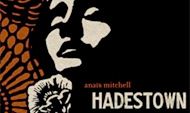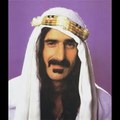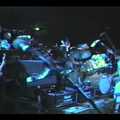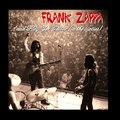
Kis hazánkban nem hemzsegnek (egyelőre) a Zappát játszani kívánó kis virtuózok, így most - ahogy a korábbi kottákkal is - inkább a jövőnek üzenünk. Heló, 2024!
Forrás: zappa.com fórum (Total Guitar, 2005).
Az utolsó példában 7 nyolcad hang szerepel
egy 4/4-es ütem fölött (amiben ugye 8 darab
nyolcad hang van ütemenként), ezért minden
hang mintha mindig egy kicsivel korábban
szólalna meg, ami tulajdonképpen...
a tengeribetegség zenei megfelelője. (lásd legalul!).
És ilyen ha valaki eljátszik egy teljes szólót (Gee, I Like Your Pants - emlékszünk a múltkori csodára?):
Ugyanő, Rat Tomago:
De volt itt már egy elképesztő Sinister-átértelmezés is egyszer.
Zappa-szólók, talán hollandul:
ennek egy angol fordítása:
Frank Zappa
Solo-study
In spite of his most ingenious compositions, Zappa often felt mos at ease on stage, delving in a world of improvisation only he could enter...
By Adrian Clark
The music of Frank Zappa covers a large scale of instrumental possibilities, among them musique concrète, symphonic orchestration and the super-human capacities of the Synclavier. But one instrument is always present: the guitar. Though Frank did not learn to play until he was 18, he created very quickly a unique and instant-recognizable style on the instrument. Listen to Freak Out, the debut album of the Mothers of Invention from 1966.The more his technique and his career advanced, Frank started to give way to his guitar-playing, by long, constantly inspired, improvised soloing. It is sad that Frank's unique views on the guitar were silenced when he passed away in december 1993 of prostate cancer.
Many of Zappa's musical themes were born as phrases in an improvised guitar solo.Sometimes this composition technique was carried out into the extreme - the third movement of the ballet Sinister Footwear is an orchestra-arrangement of an improvised guitarsolo! Also, Frank used solos to bring balance into his music, for instance by playing a long scream on the guitar over a complex work or a short comical musical fragment.
But now to get to the bottom of it. I noted a number of typical Zappa-ish phrases that should give you a glimpse into the Zappa style. Believe me, a few examples is enough!
Blue box: Language Tip
Improvisation: spontaneous instant composition, normally used for solos. Zappa called his compositions "air sculptures".
Exercise 1: key patterns.
Let's start at the beginning: Frank Zappa loved to play over repeating modal vamps. Two of his favourite modes were lydian and myxolydian, that are built on the 4th and 5th tone of the major key. For my solo in Frank's style I used a repeating vamp of A major and B major chords. With these chords, you'd expect you're playing in E major, but because the chords center around A, you get an A lydian athmosphere with a bit of B myxolydian, depending on the notes you stress.
The key patterns below should help you to solve this riddle:
E Major: E F# G# A B C# D#
If you take these notes and start with a different note, you get modes.
For instance: A lydian: A B C# D# E F# G#
and B myxolydian: B C# D# E F# G# A
Both modes are identical to the major key, with the exception the augmented fourth in Lydian and the minor seventh in myxolydian.
Exercise 2: soloing on the low strings.
Frank was not too stuck with established concepts in music, and his guitarplaying reflects that opinion. While the average ready-made guitarsolo you hear on MTV is made of high, screaming notes that return with computeresque regularity and matching spiceless sound, Frank liked to opt for the dirty sounds you can only find on the low snares.
Exercise 3: Legato-techniques
* Slide yor finger up on your guitar and pull it away.
The Zappa-guitarstyle has a lot to do with the flowing sound of an overdriven amp. With a similar sound you can make long, seamless sounds thanks to legato-techniques (slides, hammer-ons, pull-offs, push up). In this example you'll mainly find pull-offs. Frank also liked to use pull-offs to open strings because of the possibility to experiment with large intervals.
Exercise 4: soloing with whole tones
whole-tone key-------------
Frank liked to vary his modes with unusual keys. This example uses a favourite technique from the 1984 tour: a descending melody that is based on the whole-tone scale. Perhaps you have not heard this key before, but it's childishly simple: it's based entirely on whole-tone distances (two frets). Do not exaggerate: Frank used these things only sporadically, so save your lengthy whole-tone adventures for the night you're thinking you're Buckethead!
Exercise 5 Soloing with legato-techniques (slides)
More legato, but this time with slides. What I'm doing here, is hard to describe, because I'm just doing something. The secret behind this type of licks is varying with the umber of notes between the slides, and by changing the rhythms. The phrases you get float over the underlying beat, a sound I always associate with Zappa.
Exercise 6 Soloing with parallel fourths
Another musical technique you find in Zappa's music is the usage of parallel fourths. In case you didn't know, a fourh is the interval of 5 semitones, eg from A to D or from C to F. This example uses two licks that are made of stacked parallel fourths (I slightly changed the order of the notes). Frank didn't just use these things in his improvisations; listen to The Black Page and you'll hear what I mean.
Exercise 7 Soloing with rhythmic accent changes
And finally: rhythm. Page through a transcript-book of Zappa solos and you'll find a lot of scary rhythms. Even in my clumsy ode to Frank you find weird patterns. For this last example, I chose for rhythmic accent changes.
By playing a lick with 7 eigth notes over a straight 4/4 beat (which of course has 8 eights per beat) the one sounds hals a tick earlier every time, the musical equivalent of... ehm... sea-sickness.
Hehe.













